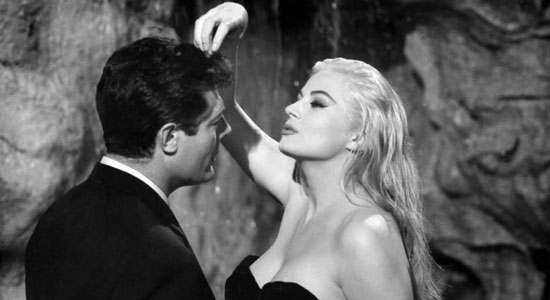MAGNET contributing editor Jud Cost is sharing some of the wealth of classic films he’s been lucky enough to see over the past 40 years. Trolling the backwaters of cinema, he has worked up a list of more than 100 titles—from the ’20s through the ’80s—that you may have missed. A new selection, all currently available on DVD, appears every week.

La Dolce Vita (1960, in Italian with English subtitles, 175 minutes)
La Dolce Vita (“the sweet life” in Italian) was certainly meant by director Federico Fellini to be taken with a large dollop of irony. Marcello Rubini (Marcello Mastroianni), a journalist who acts more like a publicist, is on-call for the “beautiful people” who jet into Rome, including Sylvia (Anita Ekberg), a platinum blonde Swedish film star who resembles Marilyn Monroe on human growth hormones.
It would be hard to top the “everything’s for sale/anything goes” message of the opening sequence of this three-hour epic, as Marcello buzzes through the skies of Rome, following a lead helicopter carrying a large statue of Jesus down below, suspended from the armpits by a thick cable as though he’s water-skiing in the air. Bikini-clad girls, catching rays on an office rooftop, holler out at Marcello, asking where he’s going. “To the pope,” he shouts back, but they can’t hear him.
“I like Rome. It’s like a tranquil jungle,” says Marcello to his blasé newest conquest, Maddalena (Anouk Aimée). “You have too much money. We are among the few people left to be unhappy.” For kicks, they pick up a prostitute in Maddalena’s Cadillac and go back to her place for the evening. “Get good money from these guys. They’re richer than Onassis,” shouts her pimp as the limousine squeals off into the sunset. Marcello and the haunted Maddalena make love on the hooker’s bed. When confronted by the pimp the next morning about her low cash return, the prostitute says, “Hey, they did everything on their own.”
Marcello returns home to find Emma (Yvonne Furneaux), his distressed live-in girlfriend, passed out in the hallway from a drug-overdose attempted suicide. He rushes her to the nearest hospital in his Triumph sports roadster, where she has her stomach pumped, not for the first time.
Marcello is soon off to his next press project, the arrival via Alitalia of Sylvia, Sweden’s new “it girl.” With boundless energy, Sylvia runs up the steps of St. Peter’s just to hear the magnificent ringing from the Vatican’s bell tower, then asks to see something that Marcello explains is in Florence, not Rome. She fields cotton-candy questions at a press conference with ease. When asked what she wears when she sleeps and what things she likes in particular, she replies, “I sleep only in two drops of French perfume. And there are three things I like: love, love and love.”
Who better to document every move of this rudderless subculture that would one day sprout such baffling personalities as Paris Hilton and Kim Kardashian, famous only for being celebrities, than a horde of newspaper photogs chasing after them through the streets. One of the chroniclers of the rich and famous here is called Paparazzo (Walter Santesso), whose character’s name has now become synonymous with the job title.






